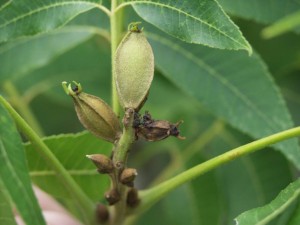We’re getting close to the time of year when pecan growers become concerned about spraying for pecan nut casebearer. Historically, this spray has always gone out in mid-May in the Albany area. We’ve seen many years in which high trap catches resulted in no nut damage and also years in which nut damage was visible with very few moths caught in the traps. Two consecutive days of trap catches tell you that egg laying by female moths may begin in 10-14 days. So far this year, we have not heard of any trap catches in Georgia aside from a small amount in extreme South Georgia.
However, all the research in Georgia indicates that treating for casebearers based on trap numbers is a bad idea. Most entomologists (UGA and USDA) now agree that casebearers rarely ever reach population levels high enough to cause economic damage to pecan in Georgia. You may see a little damage but rarely is it so great that the cost of control is justified. In fact, in years with a heavy bloom, which we appear to have in 2014, you may benefit from allowing casebearers to thin the crop load for you a little. Ted Cottrell and Will Hudson have a thorough article on why casebearer control is usually unnecessary in Georgia in the latest issue of the Pecan Grower Magazine.
If growers choose to spray anyway, avoid broad spectrum materials like Lorsban or pyrethroids. Belt, Intrepid, or Dimilin are better choices for those who will sleep better at night when spraying. Check the Pecan Pest Management Hotline (1-800-851-2847) for updates on trap catches.

